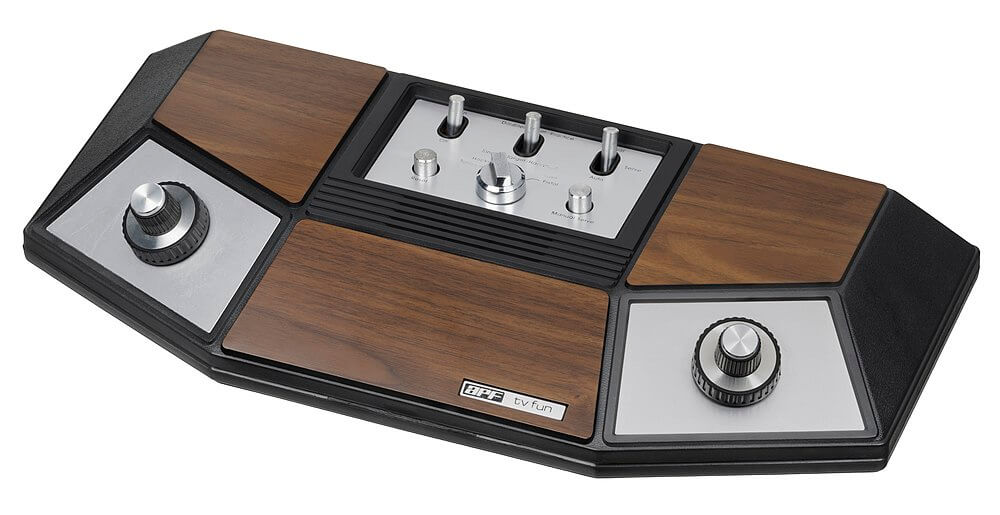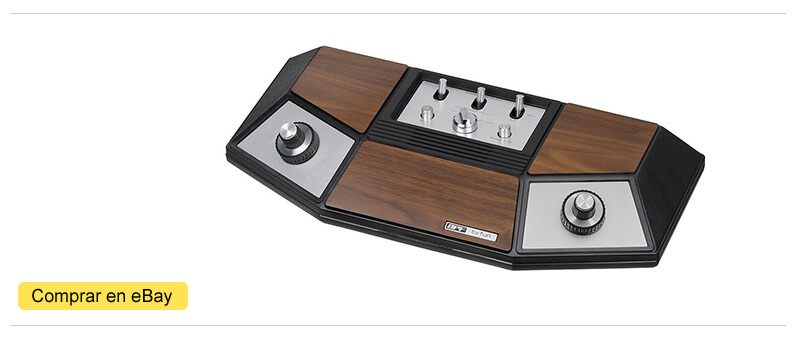The APF TV Fun is a dedicated video game console belonging to the first generation of consoles, a retro machine based on the popular AY-3-8500 chip from General Instrument, which enabled it to offer different variants of PONG games such as the classic tennis , Basque pelota, hockey and handball plus pistol depending on the version.
Unlike many of its competitors, the APF TV Fun had considerable success, so it was a console with different models (evolutions), varying in terms of chipset, color, controls and games in just 2 years. Let’s meet the APF TV Fun, the console that was created to take on Atari Pong.
| COMPANY: | APF Electronics Inc. |
| GENERATION OF CONSOLES: | 1ST GENERATION OF CONSOLES |
| RELEASE DATE: | 1976 North America |
| GAMES CATALOG: | 4 or 5 sets depending on the model |
| LAUNCH PRICE: | US$125 |
| PROCESSOR: | AY-3-8500 General Instruments |
| FORMAT: | Integrated |
| BUY IT ON EBAY: | https://ebay.us/kjF4yb |
- History of APF TV Fun
- Price of an APF TV Fun console. How much did it cost?
- Collect the APF TV Fun.
- Buy an APF TV FUN.
- TOP Retro: Best games from APF TV Fun.
- FAQ APF TV Fun.
History of the APF TV Fun console
And it is that they were other years, the 70’s, a time in which the bases and foundations of video games were consolidated day by day, action after action, error after error and success after success. The manufacturers that joined the new video game market currently had to make decisions as surprising as the following: Color or black and white? Chip or analog? Built-in or wired controls? Battery or current?
The APF TV Fun in its different versions was a color and black and white console, it had built-in and cable controls and could be played on batteries or plugged in, with games for 1, 2 or 4 players (depending on the model). . All adorned with a “magnificent” wood-style design, to go with the North American living rooms of the time, literally.
The APF TV Fun was released in 1976 with the goal of competing with the Atari Pong machines and their numerous clones, with the APF console itself being considered a Pong-like clone today. We find ourselves with a machine that was remarkably successful compared to the hundreds of clones of its time, something that was by no means easy to obtain in those days.
As used to happen in the early years of video game consoles, its manufacturer was a family business, in this case North American: APF Electronics Inc. Specialized in consumer electronics, they began their journey by importing Japanese sound equipment to the United States, specializing in later on calculators and eventually having a factory in Hong Kong while ordering products from third-party firms in Taiwan and Japan.
Consequently, the guys from APF were not inexperienced in the field of electronics in a time when the manufacture of a console was relatively simple, compared to current video game consoles. From calculators they made the leap to video games, and once their first video game console was created, they improved it to position it by launching different versions, in years in which every few months the technological barrier was broken and new milestones were marked, crazy .
Background of the APF TV FUN and context
The 70’s were a revolution in electronic entertainment, the arrival of commercial video games in both console and arcade formats, was leaving aside board games in homes and electromagnetic machines in arcades. They continued to live together as they do today, but a new industry had come to stay and take over a large part of the cake.
The pioneers of video games, such as the Magnavox Odyssey console and the Space War!, Computer Space or the well-known Pong from the early 70’s, were followed by an explosion of creativity with new machines and technology like never before: It was the Beginning of the History of Videogames, each new original title created a new genre and every few months technology gave new possibilities to programmers.
To get an idea of the rapid evolution of video games in those early years, Atari’s first console, the Atari Pong (Tele-Games Pong for purists), released in 1975, was followed by 20 models made between 1975 and 1977 by Atari itself, something surreal from our current point of view. Meanwhile, in Japan, Bandai launched eight different models of its Bandai TV Jack console in 1977 alone. A new market had been created and in a short time it would be ultra saturated, everyone wanted their piece of cake.
The original Atari Pong was accompanied by countless direct Pong clone consoles or improved with more variants of the game and additions such as pistols and light guns, filling the market with consoles that, in practice, offered the same games with more or less variations. , just like the APF console. Much of the blame for this boom in new Pong-type consoles was due to the creation and cheapening of General Instrument’s AY-3-8500 dedicated chips and the like. Chips that offered an “all in one” for manufacturers, who only had to choose how many games they offered to their customers, depending on the model they had bought.
As if there weren’t enough competition with the hundreds of dedicated first-generation Pong consoles, in 1976 Fairchild Channel F inaugurated the second generation of video game consoles with Gerald “Jerry” Lawson’s great invention, the cartridge, which was adopted by the industry for many years. Popularized by the Atari 2600 in 1977, only a year after the launch of APF TV Fun… Are you aware of the reduced times in which everything happened?
And the recreational ones? The real stars of the 70’s were the arcades and their video game temples, the arcades. If in the domestic market they made an effort to offer us the best variant of Pong, the arcade machines were much more advanced: Sea Wolf, Gun Fight, Indy 800, Breakout and Death Race, all of them launched in 1976, coexisted with pinballs and electromagnetic machines such as Mini Laser Clay or the EVR Race both from Nintendo. Midway, Taito and Atari set the course for video games with a Nintendo and Sega that gradually positioned themselves before giving the big blow.
It was in this context that APF decided to launch its console. A new market in which hundreds of companies were trying to place thousands of Pong-derived consoles, while a few brands were preparing the arrival of their second-generation consoles… These APF brothers are brave.

Models of the APF TV Fun
As we have just mentioned, the arrival of chips dedicated to video games type AY-3-8500 “all in one”, reduced the number of components to a minimum, leaving the manufacturer practically only had to make the case, controls and wiring. Consequently, most companies at the time chose to offer several models with more or fewer games (and different prices). Those were times when they tried to take over the market and get the most out of it, they did not seek to build customer loyalty as today, since the dedicated consoles did not have cartridges, the income was only acquired once and there was no perception or knowledge of the video game industry as we know it today.
RETRO CURIOSITY! To understand the absence of rules and trends in the video game market of the 1970s, we can study the case of two Nintendo Pong consoles: Color TV-Game 6 and Color TV-Game 15. Both were the same console inside, with the only difference in price and housing. The idea was that the cheap price of the Color TV-Game 6 of ¥9,800 would attract customers as a lure, and once in the store they would see the price of the Color TV-Game 15, ¥15,000. Being a price in comparison obviously more profitable in relation to price / games (in addition to having removable controls), the logical thing would be for the client to opt for the second option. In turn, Nintendo took over and thus attacked the video game market both in its economic and more expensive aspects. If today Sony, Microsoft or Nintendo sold us the same console at different prices... Troy would burn.
Let’s keep going. On the other hand, technology advanced and every few months new advances appeared that exceeded performance or lowered production costs, this being another fundamental aspect when creating new models of a machine, thus surpassing the competition that did not opt for update. The result, in its short but intense life, the APF TV Fun the following models:
| Modelo 401 | 4 games | Rifle No | 2 players | original shell |
| Modelo 402 | 5 games | Rifle Sí | 4 players | original shell |
| Modelo 405 | 4 games | Rifle No | 2 players | Model APF Match – square |
| Modelo 406 | 4 games | Rifle No | 2 players | Model APF Match – square |
| Modelo 442 | 5 games | Rifle No | 2 players | original shell |
| Modelo 444 | 4 games | Rifle No | 4 players | original shell |
| Modelo 500 | 20 games | Space | not released |
It should be noted that in addition to the differences presented in this table, the different models also differ in game modifiers (angle, difficulty levels, speed…), dedicated chip and black and white or color output. As we have already mentioned before, due to the ease of manufacturing a console with an “all-in-one” chip, in those years the companies chose to try to corner the market, the idea was to launch a large number of models to monopolize all the possible space in front of to his rivals.
And why do we include the APF TV Fun Model 500 in this table if it was never released? Well, that’s because…
RETRO CURIOSIT! The APF TV Fun 500 was a much more advanced machine compared to the rest of the models, the console incorporated controls/potentiometers and inside it there were 20 space games with their missile shots, gravity and others... Many similar to Pong, but it was an evolution. The problem? In 1977 much more evolved machines were already being launched, so APF chose not to launch this "Space APF". But, as the APFs are mostly manufactured in Japan and ordered from third-party brands, there was a Japanese company that was interested in the never-marketed console and decided to launch it under its own brand, we are talking about Bandai itself and its line of TV-Jack consoles. , being the marketed Bandai Video Mate TV-Jack 2500, really a refurbished APF TV Fun 500. Below you can see the two consoles.

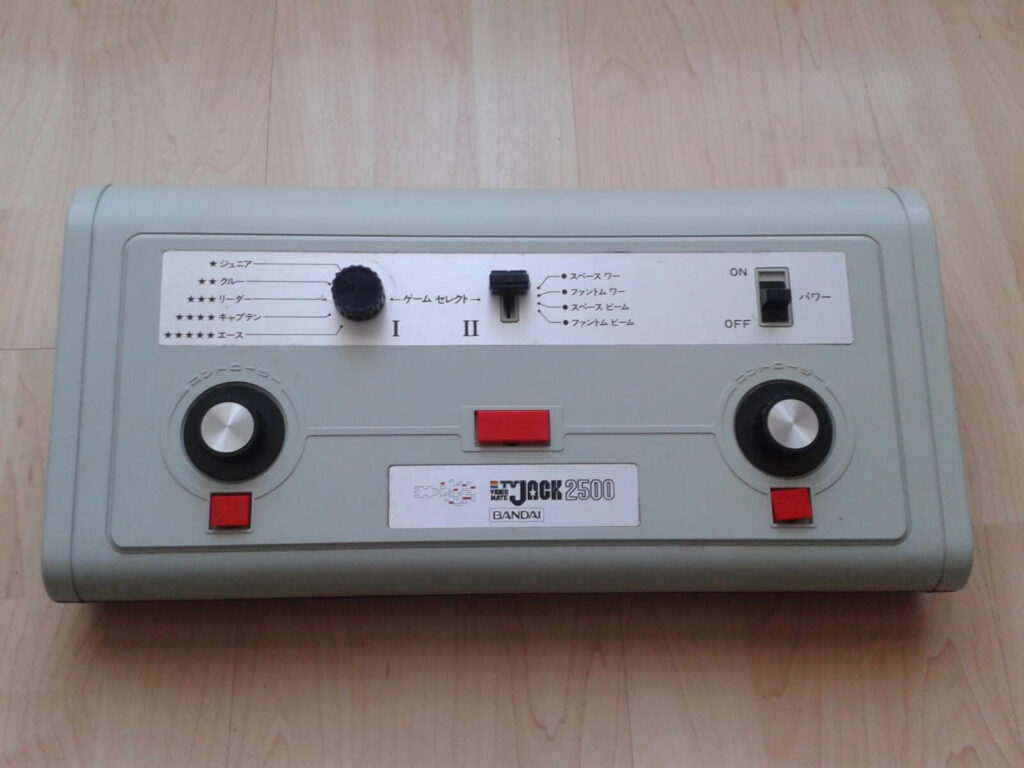
The competition and decline of the APF console
As we have already seen, the 70’s were very busy years in the video game market. The APF TV Fun was created to rival the Atari Pong, its variants and clones, something that it initially achieved, but shortly after being on the market the first second-generation consoles arrived, systems that brought with them great innovation in the world of video games: the cartridge.
The second generation came hand in hand with a new physical format, video game consoles were no longer mere dedicated clones of PONG and will become entertainment centers for all tastes, all you had to do was change the cartridge. With the incorporation of new technological elements, the difference between the first and second generation was abysmal, APF TV FUN had to deal with the following 2nd generation consoles from the very year of its launch:
- Fairchild Channel F, 1976.
- RCA Studio II, 1977.
- Atari 2600, 1977.
- Bally’s Astrocade, 1978.
- Magnavox Odyssey², 1978
- Intellivision, 1979
Big words. The APF console could hardly cope with these machines, so in a very short time it suffered the same fate as the entire Pong-type clone market, ending up on the dark shelves of cabinets and storage rooms. Pong and its variants had saturated the market and the first generation of consoles was in free fall with no prospect of recovering, the second generation deepened specialization and R&D and offered much more advanced systems. The APF TV Fun could have little compared to this new generation.
Fortunately, it is true that many machines fell into oblivion after the arrival of the cartridge and its new systems, but luckily the players continued to demand video games, they had not tired of playing, they had tired of Pong… Video games were consolidated as a new industry with a great future both in homes and in recreational areas. The APF TV Fun and its generation fell, but video games continued. Glory to video games.
The successors of APF TV Fun

Unlike many other companies of the first generation, APF did venture to make the technological leap to the second generation with a cartridge console, the APF-M1000 and the APF-MP1000 (two models) in 1978, being a console 8-bit with a Motorola 6800 CPU (by number of transistors), 1KB of RAM, and a Motorola 6847P graphics chip. What difference was there between the two models? Here comes the good…
Nothing really, the only difference is that apparently the APF-M1000 model was released together with the APF Imagination Machine, a combo/peripheral that included the console itself and turned it into a computer with a keyboard, cassette, sound synthesizer, BASIC and the possibility of adding storage cartridges, disk reader, RAM expansion and even a modem… All this in 1979, a real CRAZY.
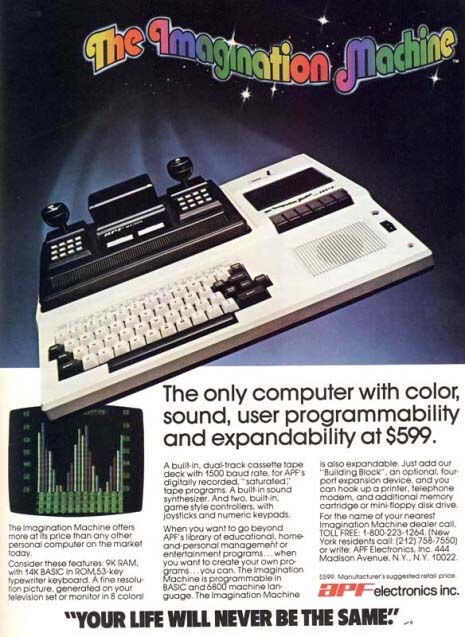
Both the retro console APF-MP1000 and the APF Imagination Machine were launched to compete against the Atari 2600, something that as you know practically nobody achieved, neither did APF. After these last two machines, no new consoles are known, but there is a rather curious device that is on the fine line between a calculator and a video game: The APF Mathemagician, a modified calculator designed to learn and play, the dream of all schoolchildren.
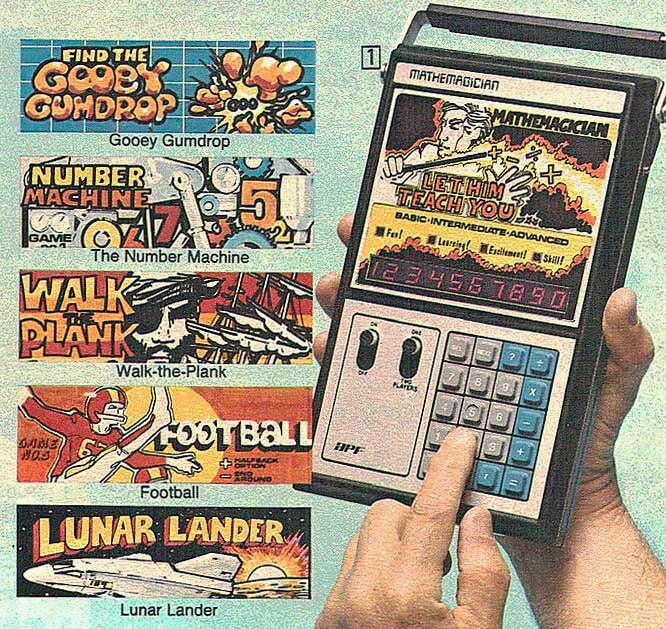
The gaming experience, is it currently playable?
I won’t go into much detail… It’s a museum piece, a piece of video game history and a console worthy of being in any self-respecting collection of retro consoles (we have it at Infoconsolas), but no, it’s not currently playable at unless you are already a few years old, you were born in the United States and you have the aggrandizement factor of nostalgia. If this is not the case, we find ourselves before a magnificent machine to collect, but not to play an entire afternoon. This is what happens with the first generation consoles.
The price of the APF TV Fun retro console
Below you have the prices of different retro video game consoles from the same era, so you can compare and get an idea of what the video game scene was like in those years.
| CONSOLE | LAUNCH | PRICE | BRAND |
| Magnavox Odyssey | 1972 | US$99.9 | Magnavox |
| Tele-Games Pong | 1975 | US$98.95 | Atari |
| Atari Pong IV | 1976 | US$98.95 | Atari |
| APF TV Fun | 1976 | US$125 | APF |
| Coleco Telstar | 1976 | US$50 | Coleco |
| Fairchild Channel F | 1976 | US$169 | Fairchild Semiconductor |
| Atari 2600 | 1977 | US$199 | Atari |
| Bally Astrocade | 1978 | US$299 | Bally Manufacturing |
| RCA Studio II | 1978 | US$149 | RCA |
| Intellivision | 1979 | US$275 | Mattel Electronics |
As you can see, the first generation consoles had “affordable” prices with the aim of covering as much of the market as possible, something that they could not maintain with the arrival of the second generation, much more advanced and expensive to produce. Even so, the investment was considerable at the time, since, for example, acquiring a launch Atari 2600 ( US$199 ) was equivalent to US$850 in 2020. Little joke…
Collect the APF TV Fun
Is it worth collecting an APF TV Fun? Yes, the answer is yes as long as you are a video game console collector. The APF TV Fun is a retro console unique and important enough in video game history to be on our shelves. Among the hundreds of Pong-type consoles that were launched, APF’s is one of the few that stands out for its good work.
But I repeat, this console is appropriate for retro collectors, in no case is it a good console for players who are not interested in collecting first generation retro consoles. The state in which you will find them on eBay will be similar to the one below (the Infoconsolas), not bad for a console that is more than 40 years old…

Buy an APF TV Fun
If you are interested in buying an APF TV Fun, you are in luck. Fortunately, in the middle of 2021 we can say that the retro console fever has not yet reached many first-generation consoles, including the APF retro console. Consequently, at a quick glance while I was writing these lines, prices on eBay range from €28 unboxed to €120 boxed with systems in more than acceptable working order. If you want to see the updated prices you just have to click on the image below.
Yes, the APF is a cheap console as you may have seen, quite a luxury for our days. These prices are due to the numerous sales it had and the still low demand for the first generation by collectors, but as we all know over time the retro fever will also come to devour the first generation consoles, so that from Infoconsolas we recommend that you do not take too long if you are interested in getting one.
STOP COLLECTOR! If you’ve seen the console listing on eBay, I want to say THANK YOU. Since 2004, the objective of Infoconsolas is to contribute to preserving the history of consoles and video games through our own collection of systems and the hours of work invested in this very website.
Being an eBay partner listing, if you buy a game or console, you will be helping Infoconsolas in the preservation of video game culture, so thank you very much again!
TOP: Best retro console games APF
Being a dedicated Pong-type console, with the games integrated into the console itself, the APF console did not have a catalog of games as we are used to today. Consequently, at Infoconsolas we have selected a video of two beefy gentlemen in which you can see the installation process of the retro console today, as well as its glorious games, the model being observed being the 402.
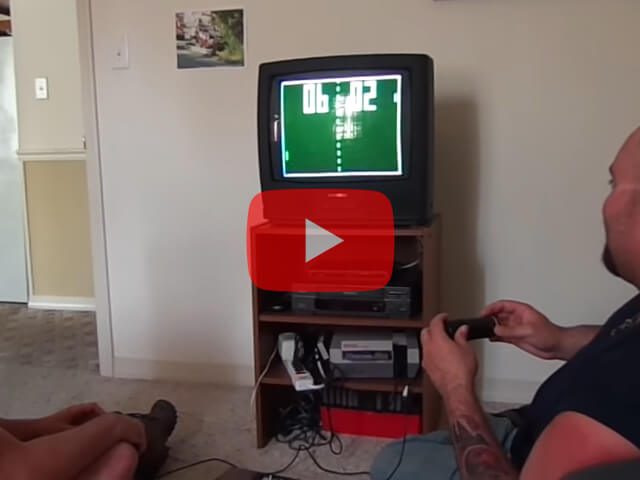
FAQ APF TV Fun
Here you have the most frequent curiosities, questions and answers of the APF TV Fun retro console, little by little we will expand this section:
In April 1976.
To the first generation of video game consoles.
It is a dedicated PONG type console.
7 models.
The 401 model and the 402 Sportsarama.
In Japan.
To the founders of the company APF Electronics Inc, the brothers Al & Phil Friedman.
Yes, in later models separate controls are included.
They alternate between 4 and 5 sets depending on the model.
They alternate between 2 and 4 depending on the model.
No, it’s all plastic.
No, the games are integrated.
It can work plugged into the mains or with 6 type C batteries, something very common in its time.
Sí, la APF-M1000.
External sources and links
- Graphic resources:
- http://discreteconsoles.blogspot.com/2015/10/bandai-tv-jack-2500-tv-jack-2500.html
- https://commons.wikimedia.org/wiki/User:Evan-Amos

